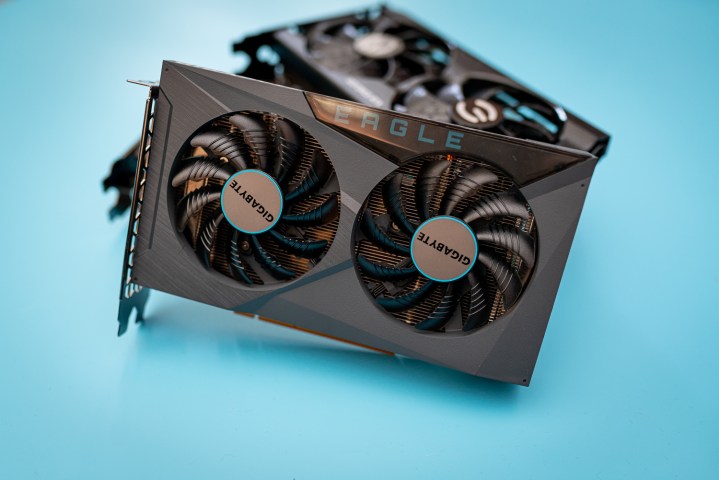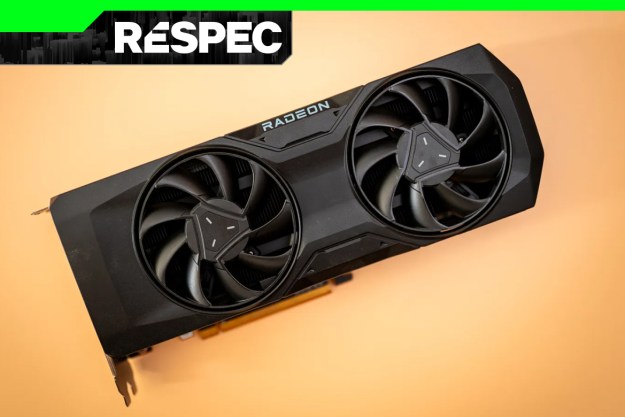Given the performance upgrades we’ve seen in recent years in regard to graphics cards, the battle between AMD and Nvidia’s upcoming next-gen GPUs is shaping up to be one of the most exciting times in tech in recent memory.
Lending credence to that theory is a new rumor outlining the technical differences between Team Red’s RTX 7000 cards and Nvidia’s RTX 4000-series.

Efficiency and performance powerhouse?
Moore’s Law Is Dead, a technology YouTuber known for his insider information, revealed some interesting details regarding AMD and Nvidia’s next-gen plans in his video The Road to RDNA 3 & Lovelace.
The first segment of the video, titled The RDNA 3 lineup is unlike anything you’ve seen, suggests AMD “should just completely blow Lovelace out of the water when it comes to efficiency.” As a result, he speculates AMD’s upcoming video cards could even ultimately outperform Nvidia’s Ada series when it comes to overall performance.
To that end, Moore’s Law Is Dead further adds that RDNA 2 versus Ampere (the architectures the current-gen AMD and Nvidia GPUs are based on, respectively) saw AMD offering generally more efficient products compared to its rival’s offerings. However, in the case of RDNA 3 versus Lovelace, he stresses that Nvidia is facing a “real, true efficiency problem coming up” in a way it hasn’t experienced before.
Elsewhere, he mentions that the technology community could be overestimating Lovelace’s performance expectations. Although he admits the Nvidia RTX 40-series will offer a huge performance increase, one that is markedly larger than Ampere over Turing, Moore’s Law Is Dead reiterates the initial target of a 66% to 80% increase, as opposed to other estimates that indicate an even higher jump.
With this in mind, Moore’s Law Is Dead’s sources suggest that the estimates for AMD’s RDNA 3 performance upgrade is apparently higher than the expectations for Nvidia’s Lovelace.
More to the story?
While we always stress to not take rumors as fact, there may be some truth behind these claims. And this is where things start to get interesting: As reported by Wccftech, a leaked LinkedIn description deriving from an AMD principal member of technical staff appears to confirm that the RX 7000 series is based on RDNA 3, with a certain model utilizing two separate processes (TSMC 5nm and 6nm). Wccftech points out that this could indicate AMD is adopting a multi-chip module (MCM) approach for its future GPUs.
Wccftech also highlights how AMD has reinvigorated the CPU market and given Intel a run for its money via its MCM Ryzen processors. Should the LinkedIn description prove to be real, and AMD is indeed integrating an MCM design for its GPUs as well, then it could very well edge out Nvidia’s Lovelace boards, at least in regard to power efficiency.
The battle of next-gen

As for which next-gen GPUs will beat the other in terms of launch periods, Moore’s Law Is Dead reiterates the general consensus that Ada Lovelace (RTX 4000-series) is scheduled for a third-quarter release, while AMD is likely to introduce its RTX 7000 video cards a few months later during the fourth quarter.
Corroborating these claims when it comes to Team Green’s next-gen GPU road map is the fact that we’ve already heard that the RTX 4090 is on track to hit store shelves in September. Moore’s Law Is Dead has also heard from sources that Ada is “for the most part ready in its design now, but they’re not quite ready with the drivers and the segmentation to get it out there.”
Why the gap between the launch periods for both next-gen GPUs? Moore’s Law Is Dead stresses that RDNA 3 is “a more complex design, really a more ambitious design.”
Theoretically, those extra few months could therefore be enough to allow AMD to take the “efficiency and performance crown,” which is why the company “knows that this launch needs to be perfect.”
Before the battle of next-gen GPUs comes to fruition later in the year, we’ll see a taste of things to come in the form of Nvidia’s new flagship RTX 3090 Ti board going up against AMD’s Radeon RX 6950XT.
Nvidia may have edged out its main rival in 2021, but if the aforementioned video is anything to go by, AMD is adamant in its intention to make sure history doesn’t repeat itself moving forward.
Ultimately, regardless of whoever comes out on top, competition between these two technology titans makes one thing certain: Before the arrival of 2023, the GPU market will usher in the most advanced graphics card we’ve seen yet.
Editors' Recommendations
- Nvidia could flip the script on the RTX 5090
- AMD’s graphics card sales just took a nosedive
- AMD’s canceled GPU could have crushed Nvidia
- I’ve reviewed every AMD and Nvidia GPU this generation — here’s how the two companies stack up
- You shouldn’t buy these Nvidia GPUs right now




